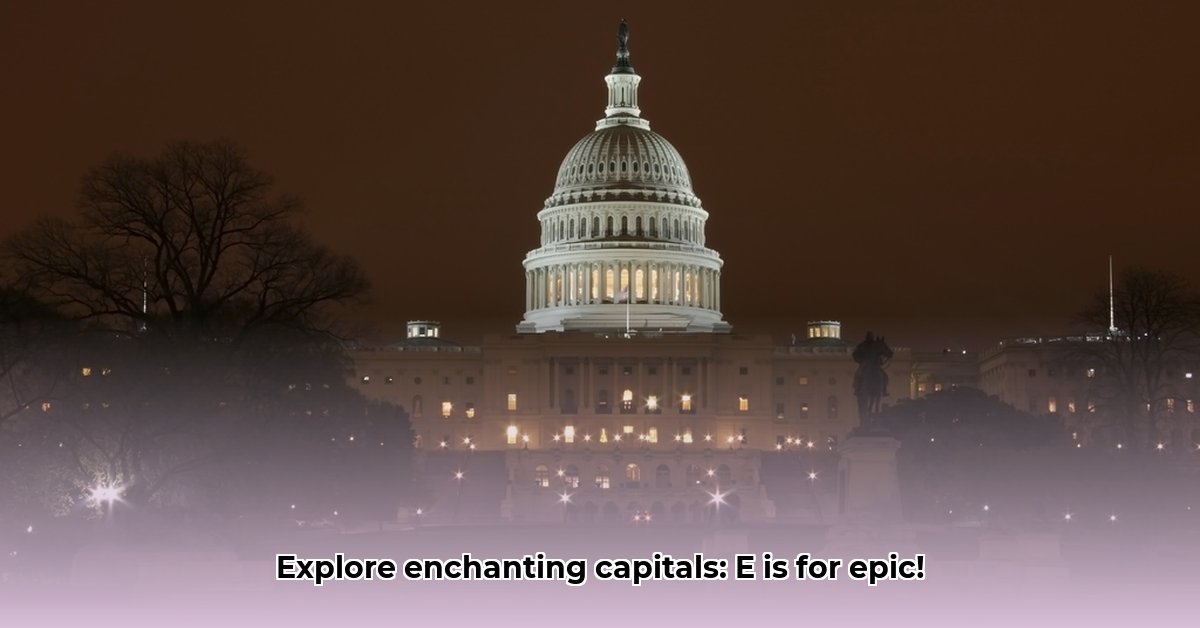Ever wondered how many capital cities start with the letter “E”? It’s fewer than you might think! But those that do offer an amazing variety of cultures and histories. From grand old European cities to more unexpected locations, this list gives you the lowdown on each one. Get ready for a quick trip around the world, exploring some fascinating places – you might even find your next travel destination here!
Capital Cities That Start With E: A Global Journey
It’s a surprisingly small club, but those that do offer a fascinating glimpse into diverse cultures and captivating histories. Let’s set off on a journey to explore them!
We’re not just looking at names on a map; we’re diving into the heart of these cities, discovering their unique stories and what makes them tick. Think ancient castles, bustling markets, and maybe even a bit of political intrigue! We’ll uncover the stories woven into the very fabric of these captivating places.
Edinburgh: Scotland’s Majestic Capital
Let’s start with a classic: Edinburgh, the undisputed capital of Scotland. Imagine rolling hills, a dramatic skyline punctuated by Edinburgh Castle looming over the city, and cobblestone streets that whisper tales of centuries past. It’s a city that effortlessly blends its rich history with modern vibrancy, offering a wealth of experiences. Explore its iconic castle, wander through the charming Old Town (a UNESCO World Heritage Site), or soak in the lively atmosphere of its pubs and festivals. Don’t forget to hike Arthur’s Seat for panoramic views. Edinburgh offers something to enchant everyone, from history buffs to art lovers.
Edinburgh’s history is deeply intertwined with the Scottish monarchy and the nation’s struggles for independence. The castle has served as a royal residence, a military stronghold, and a storehouse for the crown jewels. The Old Town’s closes and wynds (narrow alleyways) teem with stories of intrigue, while the New Town reflects Enlightenment-era urban planning at its finest. Today, Edinburgh thrives as a center for finance, education, and tourism. The annual Edinburgh Festival, a collection of arts festivals, attracts visitors from around the globe.
El Aaiún: A City at the Crossroads
Next, we travel to El Aaiún, often cited as the capital of Western Sahara. This is a city with a complex and sensitive history, reflecting the ongoing dispute over the territory it sits within. Its location on the Atlantic coast of Africa has made it a focal point for competing claims and geopolitical interests.
The city’s identity is shaped by its blend of Sahrawi, Spanish, and Moroccan influences. The architecture reflects this, with a mix of colonial-era buildings and more modern developments. The traditional Sahrawi culture, with its nomadic roots and strong oral traditions, remains an important part of El Aaiún’s character. However, the political situation means that access to the city and the surrounding region can be restricted. Travelers should exercise caution and be aware of the potential for demonstrations or political activity.
Erbil: Ancient Citadel, Modern Metropolis
Our final stop takes us to Erbil, the capital of the Kurdistan Region of Iraq. This is a city that beautifully merges ancient history with modern development. The Erbil Citadel, a UNESCO World Heritage Site, provides a tangible link to a past stretching back millennia. This massive ancient fortress dominates the city’s skyline, a silent witness to centuries of shifting empires and cultural exchanges.
Erbil is considered one of the oldest continuously inhabited cities in the world, with evidence of human settlement dating back to at least the 6th millennium BC. The Citadel itself has been occupied by successive civilizations, including the Sumerians, Assyrians, Babylonians, Persians, and Ottomans. Today, Erbil is a bustling hub for trade, commerce, and culture. It is also a key center for the Kurdish people, who have long sought greater autonomy and self-determination. Explore the vibrant bazaars, sample the local cuisine, and experience the warmth of Kurdish hospitality.
More Than Just Locations: A Deeper Dive
These three cities – Edinburgh, El Aaiún, and Erbil – might seem geographically disparate, but they share something in common: each is a capital city with a distinct character and a story waiting to be discovered. These are not just places on a map; they are living entities with rich and compelling histories.
While the number of capital cities starting with “E” is relatively small, it allows for a deeper, more focused exploration of each city’s individual features. Instead of a quick overview, we can truly delve into the rich tapestry of their histories, cultures, and societal dynamics. And that’s what makes this journey so compelling, and what sets them apart from other places.
Planning Your Expedition: Practical Tips
Ready to plan your own “E” capital adventure? Here are a few things to consider:
Edinburgh: Expect a vibrant, walkable city. Summer months offer the best weather for exploring its many outdoor attractions. Booking accommodations in advance, particularly during peak tourist season, is highly recommended. Consider purchasing a “Royal Ticket” for access to multiple historic sites.
El Aaiún: This requires more in-depth planning due to its unique geopolitical context. It’s crucial to check current travel advisories from your government and be informed of any safety concerns. Learning about the political landscape and the history of the Western Sahara conflict is essential before traveling. Secure necessary permits and permissions well in advance.
Erbil: You’ll find a captivating mix of ancient and modern elements. Learning a few basic Kurdish phrases can significantly enhance your interaction with locals and greatly enrich your experience. Dress modestly, especially when visiting religious sites. Be aware of the ongoing security situation in the region and follow any advice from local authorities.
Each city presents its own set of logistical considerations. Thorough research and planning are key to making the most of your journey and ensuring a safe and enriching travel experience.
The Ongoing Story
The stories of these capital cities continue to unfold. Ongoing research and developments are constantly reshaping our understanding of their pasts, presents, and futures. The political landscape in places like El Aaiún and the Kurdistan Region is particularly dynamic. These are not static entities; they are living, breathing cities constantly evolving, undergoing transformation, and their stories are constantly being rewritten. So, consider this article just a starting point for your own deeper exploration. Go ahead, explore! What stories will you uncover?
How to Analyze Historical Shifts in Global Capital City Locations
Let’s embark on a journey exploring capital cities whose names begin with “E.” But before we delve into the specifics of these fascinating urban centers, let’s consider a crucial question: how to analyze historical shifts in global capital city locations? Understanding these shifts reveals much about a nation’s evolution.
Unpacking the “Why” Behind Capital City Moves
Think of a capital city as the beating heart of a nation, the central nervous system that drives its functions. Relocating it is a monumental decision, akin to major surgery. Why would a nation undertake such a drastic measure? Several factors frequently drive these decisions. Security concerns, like the need to escape volatile regions or to create a more defensible location, are a common catalyst. For example, Brasilia was built as a new capital of Brazil to move the government away from the coast, which was vulnerable to naval attacks.
Economic disparities might necessitate a shift, aiming to stimulate growth in underdeveloped areas. The relocation of Nigeria’s capital from Lagos to Abuja was partly motivated by the desire to create a more centrally located and economically balanced capital.
Political factors, such as the desire for a fresh start, to symbolize a new era or to shift power dynamics, also play a significant role. Sometimes it’s about creating a more centrally located administrative hub, improving governance and accessibility for the entire country, fostering a sense of national unity.
Deciphering the Data: A Multifaceted Approach
Analyzing these historical shifts requires a multi-pronged approach. We cannot simply look at the “when” and “where” of these moves; we must understand the why. This involves examining:
- Political landscape: What were the prevailing political ideologies and power struggles at the time of relocation? Who were the key players and what were their motivations?
- Economic conditions: Were there significant economic disparities or opportunities that influenced the decision? Were natural resources discovered, or was there a need to diversify the economy?
- Geographical factors: Did the move aim to improve strategic positioning, accessibility, or resource management? Was the old capital prone to natural disasters?
- Social dynamics: How did the relocation impact the lives of citizens, both in the old and new capitals? Did it lead to displacement, migration, or changes in social structures?
- Long-term consequences: What were the lasting effects—positive or negative—on the nation’s development? Did the relocation achieve its intended goals, or did it create new problems?
Consider the nuances. Were there widespread protests or resistance to the move? What was the economic impact on both the old and new centers? Examining these elements reveals the full story behind each relocation.
Case Studies: Learning from History
To effectively analyze historical shifts, studying specific examples is crucial. By comparing and contrasting different relocation scenarios, we can identify common patterns and draw broader conclusions. Did the relocation achieve its intended goals? What unforeseen challenges arose? Were there better alternatives? These questions inform our understanding of the process.
Edinburgh: A Case in Point
Edinburgh, the capital of Scotland, offers a rich example for analysis. Its history reflects centuries of political and economic shifts that shaped its role as a capital. Exploring its historical context allows us to understand better the factors that contributed to its enduring status. Edinburgh has maintained its capital status despite numerous challenges, including periods of English
- Spiritual Connotation of Names Reveals Their Divine Meaning and Purpose - November 18, 2025
- Unpacking the Importance of Names in the Bible for Deeper Understanding - November 17, 2025
- Avery Biblical Meaning Infers Wisdom, Counsel, and Protection - November 16, 2025










